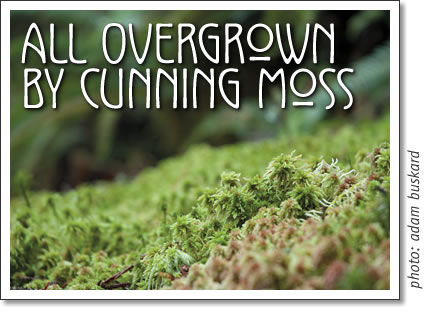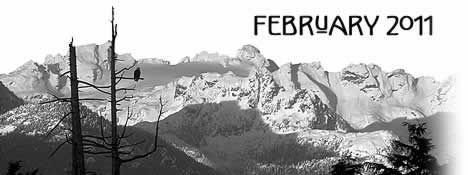
Tofino: All overgrown by cunning moss...
by Josie Osborne, Tofino
 All overgrown by cunning moss,” begins Emily Dickinson’s poem about the death of the 19th century author Charlotte Bronte. Indeed, cunning might be an apt adjective for this small plant that appears at almost every turn in Clayoquot Sound. It carpets rocks and soil, it creeps up the woody stems of small trees, it forms spongy mats high in the forest canopy in the crooks of the branches of 800 year old conifers. It plays a critical role in the forest, preventing soil erosion, acting as a sponge to slowly release water after a good rain, and providing a home and food to myriad insects and other life. But it also infests roofs, sidewalks, the rubber sealing strip on car windows and is the bane of existence to gardeners addicted to turf lawns. (Clearly, these gardeners have not yet embraced the finer qualities of this exceptional little plant.)
All overgrown by cunning moss,” begins Emily Dickinson’s poem about the death of the 19th century author Charlotte Bronte. Indeed, cunning might be an apt adjective for this small plant that appears at almost every turn in Clayoquot Sound. It carpets rocks and soil, it creeps up the woody stems of small trees, it forms spongy mats high in the forest canopy in the crooks of the branches of 800 year old conifers. It plays a critical role in the forest, preventing soil erosion, acting as a sponge to slowly release water after a good rain, and providing a home and food to myriad insects and other life. But it also infests roofs, sidewalks, the rubber sealing strip on car windows and is the bane of existence to gardeners addicted to turf lawns. (Clearly, these gardeners have not yet embraced the finer qualities of this exceptional little plant.)
Mosses belong to the division Bryophyta - from the Latin bryos “moss” and phyton “plant” - one of 11 divisions of the plant kingdom. Physiologically, mosses are not too fancy and haven’t come very far from their aquatic algae predecessors. They differ from almost all land plants (except liverworts and hornworts) in that they lack a vascular system, a network of tubes that transport nutrients and water in a plant much like our own vascular system transports blood around our bodies. Horsetails, ferns, palms, conifers and flowering plants - almost anything green that grows on land - all have vascular systems, and this has enabled these species to grow tall and thrive in places where water is not always present or readily available. But the moss’s lack of sophistication doesn’t stop there. No vascular system means no roots, stems or true leaves. Take a closer look at a moss plant next time you step outside (you should be able to find one within 10 meters of your front door). The thin, flat leaf-like projections perform the same function as leaves, devices that contain chlorophyll to harness the energy of the sun through photosynthesis, but they are just one cell thick. Moss plant rhizoids anchor it to the ground, but unlike true roots, they do not store food or nutrients.
So, no leaves, no roots, no stems. Mosses are not as far along the evolutionary line as, say, Western red cedars with their fancy xylem (‘zy-lem’) and phloem (‘flome’), vascular structures that conduct water, sugar, and nutrients to all parts of the tree, but there are a lot more species of moss around than there are species of conifer trees. There are about 12,000 species of moss worldwide, and 900 of these occur in the Pacific Northwest. How many are in Clayoquot Sound? Well, an inventory of Clayoquot Sound vascular plants (remember, that does not include mosses, liverworts or hornworts) lists 405 species - there may be as many species of moss too, but no one has done a bryophyte inventory (yet?). Bryophytes are almost certainly holding the torch in numbers amongst the plants in the temperate rainforest. In fact, during various BioBlitzes conducted around the province - 24 hour sessions in which dozens of scientists, naturalists, and citizen scientists identify as many species of living things as they can in a defined area - bryologists regularly win for the most number of plant species listed.
Just how does a small, primitive plant without true leaves or roots manage to incite visions of a verdant paradise in some and send others to the gardening store in search of moss killers? Two traits make it particularly successful: its cunning ability to invade bare spaces previously unoccupied (like bare rock or the roof of a brand new condo) and its tenacity once it takes hold! Although they need water to survive and reproduce, mosses can also withstand periods of total dryness (botanists call that ‘desiccation’) and freezing. And in case you thought being small and flat was a bad thing, think again. Will you get wetter standing up or lying down in a puddle of water? When you’re as flat and thin as a moss plant is, not only are most of the parts of your body close to the wet surface, but capillary action draws water towards you. Smart!
Moss reproductive strategies are also a key to their success (yes, it always comes back to sex). Mosses don’t get extravagant with flowers and seeds, they just erect setae - thin stalks - which bear beak-like capsules jam-packed with spores. In one species of moss, Sphagnum, these capsules are like miniature confetti cannons - they contain compressed air which propels spores up to 20 cm away (for a plant only a few centimeters high, that’s impressive). Spores travel on the wind, and when they find the right moist, dark place - whether high in the tree canopy or on the face of a rock newly upturned by a bear at the edge of a stream - it doesn’t take long for moss plants to grow in the right conditions.
If you’ve got moss on your roof, gutters or the cedar siding of your house then you should remove it (by hand, no chemicals!). Remember, moss is essentially a living sponge, and leaving moss on wood siding or roofs is like always wearing wet socks in leather shoes; the wood will rot the way the leather would (and your toes would be permanently wrinkled). But you can also encourage moss in the right places, build a moss garden or a moss terrarium, and spend hours gazing at the tiny world of the moss plant admiring how smart, cunning, and tenacious it is. As another 19th century author, Henry David Thoreau, noted, “The beauty there is in mosses must be considered from the holiest, quietist nook.” May you never look at moss the same way again.
Josie Osborne can be found at the Tofino Botanical Gardens in Tofino.
Tofino Time February 2011
- Tofino in February 2011
- Tofino Surf Gear: Pump up the Volume
- February concerts in Tofino
- February movies in Tofino
- Tofino events in February 2011
- Tofino tides: Tide table for Tofino February 2011
- Tofino surf reports for February 2011
- Tofino Fishing Outlook for 2011
- Tofino yoga sequence: Embodied Delight
- Tofino nutrition: Top 8 Foods to promote Longevity
- Get Ready for Whale Festival!
- West Coast Winter Music Series 2010/11
- Tofino Chocolate: A sweet Treat!
- Tofino: All overgrown by cunning moss...
- Horoscope for February 2011
- Community Directory: Goods & Services in Tofino
tofino | tofino time | activities | accommodation | events | directory
maps | travel | food | art & artists | photos | horoscope | tides
search | magazine | issues | articles | advertising | contact us
hosted in tofino by tofino.net & studio tofino
© 2002-2014 copyright Tofino Time Magazine in Tofino Canada
Tofino’s wet climate presents the ideal living environment for several species of moss in Clayoquot sound.

quick links:
- tofino accomodations
- tofino calendar
- tofino surf report
- tofino horoscope
- march horoscope
- tofino map
- tofino fishing report
- tofino tides
- tofino weddings
tofino events:
- tofino concerts
- tofino events
- tofino movies
- tofino festivals
- tofino yoga classes
- tofino whale festival
tofino time magazine:
- tofino time march 2016
- tofino event listings march 2016
- tofino concerts in march 2016
- tofino movies in march 2016
- cox bay | wickaninnish beach
- chesterman beach
- tonquin beach
- tofino brewing co.
- tofino wedding guide
tofino accommodation:
- tofino cabin
- tofino camping
- bed & breakfasts in Tofino
- tofino hostels
- tofino motels
- tofino hotels
- tofino vacation rentals
- petfriendly accommodation
activities:
- tofino bike rentals
- tofino bear watching
- tofino bird watching
- tofino boat charters & cruises
- tofino fishing
- hot springs cove
- sea kayaking in tofino
- tofino storm watching
- tofino surfing
- tofino whale watching
- tofino yoga
shopping:
services:
- tofino yoga, spa & wellness
- tofino restaurants
- tofino internet cafes
- tofino travel & transportation
- tofino real estate
- tofino taxi services
- tofino wedding & events
